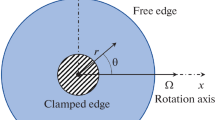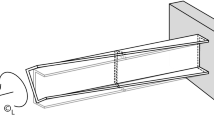Summary
Due to the warping any torsional wave or disturbance in a noncircular cylinder is propagated with a higher velocity than that predicted by the elementary theory. This change of the wave velocity depending on wave length, i.e. the dispersion phenomenon, is accompanied by certain modifications of stresses and displacements. This paper presents a systematic investigation of these “coupling effects” within the framework of the linear theory of elasticity by means of the method of strained parameters and of the technique of Lindstedt-Poincaré leading to exact solutions in the asymptotic sense. The dispersion is found to be related to the shearing stresses of higher order of magnitude and to the distortion of cross section which are consequences not only of the axial stresses and accelerations hut also of the plane stresses. The coupling between torsional and flexural vibrations which occur in the case of cross sections not having two axes of symmetry is also determined explicitly.
Übersicht
Infolge Verwölbung weisen Torsionswellen bei Stäben nichtkreisförmigen Querschnitts höhere Geschwindigkeiten auf als jene nach der klassischen St. Venantschen Theorie. Diese wellenlängenabhängige, als Dispersionsphänomen bekannte Änderung der Geschwindigkeit hängt unmittelbar mit Spannungen und Verschiebungen zusammen, welche über den Rahmen der elementaren Theorie hinausgehen. Die vorliegende Arbeit gibt eine systematische Untersuchung dieser „Kopplungseffekte“ auf der Grundlage der linearen Elastizitätstheorie wieder, welche sich der Methode der asymptotischen Entwicklungen bedient und durch Anwendung der Technik von Lindstedt-Poincaré zu asymptotisch exakten Ergebnissen führt. Es wird gezeigt, daß die Dispersion im direkten Zusammenhang mit den Schubspannungen und Querverschiebungen sekundärer Größenordnung steht, welche als Folge von durch Verwölbung bedingten axialen Spannungen und Beschleunigungen, aber auch von ebenen Spannungen zustande kommen. Die je nach Symmetrieeigenschaft des Querschnitts zu erwartende Kopplung zwischen Torsions- und Biegeschwingungen wird ebenfalls explizit erfaßt.
Similar content being viewed by others
References
Pochhammer, L.: Über die Fortpflanzungsgeschwindigkeiten kleiner Schwingungen in einem unbegrenzten isotropen Kreiscyliuder. J. reine angew. Math. 81 (1876) 324–336
Chree, C.: The equations of an isotropic elastic cylinder in polar and cylindrical coordinates, their solution and applications. Trans. Camb. Phil. Soc. 14 (1889) 250–369
Miklowitz, J.: Elastic wave propagation. In Appl. Mech. Surveys. (Ed. by H. N. Abramson, H. Liebowitz, J. M. Crowley and S. Juhasz). pp. 809–839. Washington, D.C.: Spartan Books 1966
Love, A. E. H.: A treatise on the mathematical theory of elasticity. New York: Camb. Univ. Press 1927 (4th Ed.)
Kynch, G. J.: Fundamental modes of vibration of uniform beams for medium wavelengths. Brit. J. Appl. Phys. 8 (1957) 64–73
Barr, A. D. S.: Torsional waves in uniform rods of non-circular section. J. Mech. Eng. Sci. 4 (1962) 127–135
Nigro, N. J.: Steady-state wave propagation in infinite bars of noncircular cross section. J. Acoust. Soc. Am. 40 (1966) 1501–1508
Nigro, N. J.: The application of the Ritz method to the problems of steady-state longitudinal, flexural and torsional wave propagation in bars of rectangular cross-section. Diss., Univ. of Iowa, USA, 1965
Bleustein, J. L.; Stanley, R. M.: A dynamical theory of torsion. Int. J. Solids Struct. 6 (1970) 569–586
Engstroem, O. L.: Dispersion of torsional waves in uniform elastic rods. J. Appl. Mech. 41 (1974) 1041 to 1046
Mindlin, R. D.: Low frequency vibrations of elastic bars. Int. J. Solids Struct. 12 (1976) 27–49
Fraser, W. B.: Dispersion of elastic waves in elliptical bars. J. Sound Vib. 10 (1969) 247–260
Fraser, W. B.: Stress wave propagation in rectangular bars. Int. J. Solids Struct. 5 (1969) 379–397
Green, W. A.: Vibration of beams-II. Torsional modes. Q. J. Mech. Appl. Math. 10 (1957) 74–78
Nayfeh, A. H.: Perturbation methods. New York: John Wiley & Sons 1973
Cole, J. D.: Perturbation methods in applied math. Waltham, Mass.: Blaisdell 1968
Sayir, M.; Mitropoulos, C.: On elementary theories of linear elastic beams, plates and shells. ZAMP 31 (1980) 1–55
Achenbach, J. D.: Wave propagation in elastic solids. New York: North Holland/American Elsevier, 1973
Deger, Y.: Kopplungseffekte bei Stabschwingungen. Diss. ETH Nr. 6758, Zurich (1981)
Sayir, M.: Flexural vibrations of strongly anisotropic beams. Ing.-Arch. 49 (1980) 309–323
Niordson, F. I.: An asymptotic theory for vibrating plates. Int. J. Solids Struct. 15 (1979) 167–181
Author information
Authors and Affiliations
Rights and permissions
About this article
Cite this article
Deger, Y. Coupling effects on torsional vibrations of prismatic bars. Ing. arch 55, 307–319 (1985). https://doi.org/10.1007/BF00538225
Received:
Issue Date:
DOI: https://doi.org/10.1007/BF00538225




